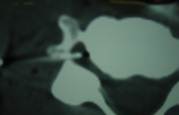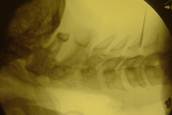For most of you, this procedure is carried out under local anaesthetic where just the area concerned is made to go numb. For some of the more involved injections, heavy sedation/light general anaesthetic is given to you by our consultant anaesthetist though even then additional local anaesthetic is used to block the nerves so as to reduce the level of post procedure pain and reduce the depth of general anaesthetic required.
Epidural injections are delivered by the anaesthetist. With you on your side, a needle is passed into the spinal canal to lie outside the sack containing the nerves and spinal fluid. Once it is satisfactorily positioned, a combination of local anaesthetic and steroid is then injected into the spine. Positioning of the needle is usually assisted with X-ray screening.
For facet joint injections, you are placed on your tummy. Needles are placed into the facet joints and injections given into them.
Guidance is used so as to ensure the needles reach exactly the right spot. We commonly use two systems either X-ray guidance or CT scans. Which depends on what injections we are going to give and this will be discussed earlier. By having both systems available we can maximise accuracy whilst minimising irradiation.


X-ray Guidance CT Scan Guidance
Informed consent
Before you have a procedure of any kind, however trivial you may feel it to be, you must be fully aware of the possible and likely consequences. You must sign a consent form in which you state that you are fully aware. Do not sign any consent form for a procedure with us unless you feel fully informed of its aims and risks, as well as the alternatives and you are fully content with everything set out below.
Please click for informed consent for treatments: operations and injections information.
When can I go home?
Most patients should be able to go home around lunchtime, though it may be a late lunch for some. Most patients go home for a few hours after the procedure is performed, when the sedation has fully worn off. However, you should not go home unless you feel up to it and someone must accompany you home.
Can I stay in overnight?
You may of course but your insurer may not pick up the bill. The fact you live far away will often not do for them. However, sometimes on overnight stay is required for medical reasons such as having other chronic health conditions or uncontrolled pain.
What can I do afterwards?
Most folk take the day off work. If you have had sedation/anaesthesia you should not be making important decisions. You may have more pain the next day – about one in ten of you do. You may not feel like working the next day but most folk are able to. You should behave as you normally do, take tablets if you are in pain as you would do normally and not take on anything extra - even if you feel better. If you are due to travel, including flying, you may go the next day providing no side effects inhibit you.
What are the risks from injections?
The procedure is safe and very seldom does it cause any lasting complication. However, any anaesthetic or spinal procedure can kill or disable. The likelihood of serious, lasting harm is very small though many patients report a temporary exacerbation in their pain, usually 24-48 hours thereafter. The sought-after improvement will usually not arise until three to four days after the injection or sometimes longer.
For female patients, it is vital they are absolutely certain they are not pregnant. If there is the smallest chance of this, you must not proceed.
Diabetic patients must take special care. The steroid in the injection can disturb your normal diabetic control. It is likely to do so to a mild degree for a day or so.
Even in the healthy, life-threatening complications can arise. However, this is very rare indeed.
The commonest serious problem is a dural tap or inadvertent lumbar puncture. This arises in about 1% of epidurals. The needle punctures the dural sac of the spine which contains all the nerves and cerebrospinal fluid. The fluid then leaks from the sac. Classically, patients get a bad headache afterwards. Usually, lying down for a few days, drinking lots of water and for reasons we are unclear, taking lots of caffeine relieves the situation.
Of course, any procedure may fail to bring the sought after relief or its benefits may be short lived.
How do I behave after the injections are performed?
The day after the injections, you should take matters gently. If you do have a long commute or your work is physically arduous, we would suggest taking the next day off. However, the idea is that thereafter you return to normal activities. Unless specifically instructed, do not take on any specific physiotherapy or exercise regime until your first review after the procedure at The Spine Surgery London.
When is my first follow-up appointment?
The first follow-up appointment is usually 10 days to two weeks after the injection. If the injections were for diagnostic purposes, we will need to discuss the implications of the result, good or bad. If the injections were as part of a treatment plan, then your first follow up will trigger the physiotherapy.
What do I do in the event of any problems?
If, once you have got home, problems arise help is available from a number of sources.
Firstly, please contact The Spine Surgery London – our PA or secretaries will be able to contact the relevant spinal specialist or our Spinal Nurse. If it is out of hours, you may also ring this number and the machine will tell you what to do in the event of an urgent enquiry.
Please go to our Contact Us page, for the relevant contact numbers.